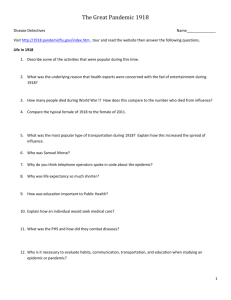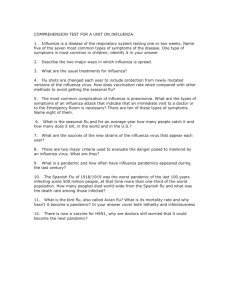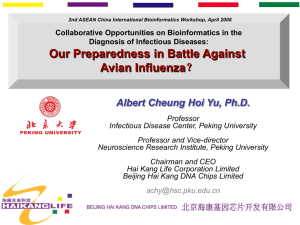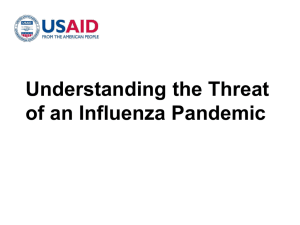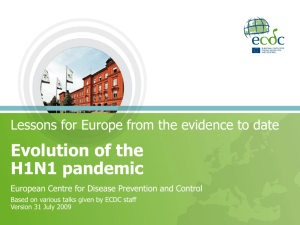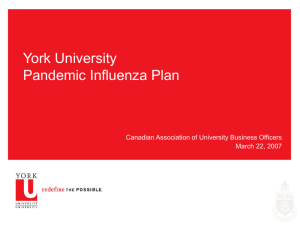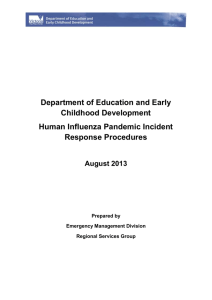Dr Louis Katz - Pandemic Influenza 101
advertisement
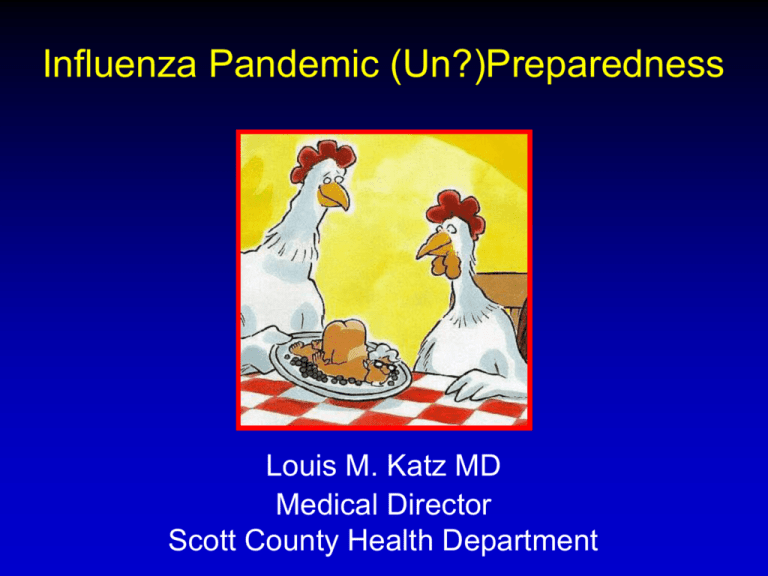
Influenza Pandemic (Un?)Preparedness Louis M. Katz MD Medical Director Scott County Health Department Human influenza types • Type A • Epidemics and pandemics • Birds, animals (swine) humans • All ages • Type B • Milder epidemics • Humans only • Primarily affects children • Type C • Never mind Influenza A • Incubation: 1-4 days (average 2 d.) • Whole respiratory tract may be involved • Abrupt onset fever, chills, malaise and muscle aches. Cough, sore throat, headache. • Duration of severe symptoms: 3-7 days • Large amounts of virus in secretions • Virus shed for 2-8 days after onset • Virus detected up to 24 hours before onset • Viral shedding in children can persist for longer Influenza A 8 segments of – sense, single stranded RNA Hemagglutinin Hemagglutinin A/Beijing/32/92 (H3N2) Neuraminidase Drift vs. Shift: Darwin lives • Antigenic Drift – Annual Influenza • Mutations leading to small change • Selection for strains which encounter the least resistance • Some immunity, but need new influenza vaccine • Antigenic Shift – Pandemic Influenza • Generally very big changes in an animal virus • Genetic reassortment of viral genes when two viral strains infect the same cell or direct jump from avian sources • New virus, minimal immunity Emergence of influenza A strains H9*1998 1999 2003 H5* H7*1980 1997 2003-2005 1996 2002-2004 H1 H3 H2 H1 1977 1915 1918 H1N1 Spanish 1925 1935 1945 1955 1957 H2N2 Asian 1965 1968 H3N2 1975 Hong Kong 1985 1995 2005 *Avian influenzas 20th century Influenza A pandemics all are not created equal Subtype Origin Viral Change Est. US deaths Shape of mortality Populations curve at risk Spread and crest 1918 Mutation from H1N1 Kansas avian strain in HA 1957 Reassortment of 3 segments from avian strain April 1957 Hong Kong, May Japan, Infants and 69,800 U or J June Chile, Oct. US elderly with second wave Feb. 1958 Reassortment China of 2 segments from H2N2 July 1968 Hong Infants and 33,800 U or J Kong, Dec. 68-Jan. elderly 1969 US 1968 H2N2 H3N2 Asia 548,000 W 3 waves 1918-19, Well young simultaneous adults around the world Mortality patterns in 3 pandemics Influenza A (H5N1) • Majority of human cases in children, almost all with exposure to ill poultry • Typical flu, evolves in 2-5 days to diffuse pneumonia • Case-fatality rate ~50% • Person-to-person transmission very inefficient • Endemic across Asia • Spread to Kazakhstan, Russia, Romania, Turkey, Greece, Croatia, Ukraine, Western Europe • Adapting to other mammals • Ducks have tolerance to infection (spread) Spread of H5N1 avian (HP) Influenza A WHO Human H5N1 through 11-13-06 WHO Steps to a pandemic (distinct from “avian flu”) 1. Animal-to-human transmission 2. Any person-to-person transmission 3. Efficient person-to-person transmission WHO pandemic phases (ref. to H5N1) Interpandemic Low risk of human cases 1 New virus in animals, no human cases Higher risk of human cases 2 Pandemic alert No or very limited human-to-human transmission 3 Increased human-to-human transmission 4 Significant human-to-human transmission 5 Efficient human-to-human transmission 6 New virus causing human cases Pandemic Impact of pandemic influenza in US if virus like 1957/1968 strains or 1918 Pandemic Influenza “Ordinary” annual Like1957/68 Like 1918 Deaths 36,000 92,500 1,200,000 Hospitalizations 200,000 400,000 5-6 million Total infections 17-50 million 120-180 million 120-180 million Missed Work Days 70 million 150 million ??? Missed School Days 38 million 85 million ??? Direct/Indirect Costs $3-15 billion $35 billion ??? Impact of pandemic influenza A in US Characteristic Moderate (1958/68) Attack rate 90,000,000 (30%) Severe (1918) 90,000,000 (30%) Outpatient care 45,000,000 45,000,000 Admissions 865,000 9,900,000 ICU care 128,750 1,485,000 Ventilators 64,875 782,000 Deaths 200,000 1,903,000 *HHS Pandemic Influenza Plan. Nov. 2005. Estimates extrapolated from past pandemics in US. Estimates do not include potential impacts of interventions not available during 20th century. Pandemic planning assumptions • Outbreaks occur simultaneously throughout US • Overwhelming demand on the healthcare system • No “outside” help • 35-45% absenteeism in all sectors at all levels • • • • Public service, public safety Healthcare personnel Just-in-time economy Critical utilities • Order and security disrupted for months, not hours or days (e.g. 9/11, or Katrina) • On multiple news outlets 24/7 What can we do?? Social distancing in 1918 (maybe) Cumulative US incidence/100 population) with various interventions Reproductive rate (Ro) 1.6 No intervention 32.6 Unlimited targeted prophylaxis 0.06 1.9 2.1 2.4 43.5 48.5 53.7 4.3 12.2 19.3 Dynamic vaccination 0.7 17.7 30.1 41.1 School closure 1.0 29.3 37.9 46.4 Travel restriction 32.8 44.0 48.9 54.1 DV, SD, SC, TR 0.04 0.2 0.6 4.5 Germann et al. PNAS. 2006 Elements of a pandemic plan • Authority, command and control • Surveillance • Vaccine management • Antiviral agents • Emergency response, surge capacity • Communications • Continuity of operations Vaccine (conventional wisdom) • Not available for 4 to 6 months • Not necessarily true • Must be matched to strain • Grossly oversimplified • Will become available in allotments, with number of doses dependent on potency • When available, distribution will be prioritized • It is likely that much of the pandemic experience will occur prior to availability Antiviral medications • Drug likely to be distributed to states pro rata • Need 45 doses of oseltamivir for 6 wks of prophylaxis vs. 10 doses for 1 course of treatment • Priority for access will be determined state- by-state • Risk/benefit • Ethical considerations Expand and enhance annual influenza vaccination • Enhance infrastructure • Expand expertise implementing large vaccination clinics • Develop trained cadre of volunteers • Enhance demand to enhance supply • Don’t forget pneumococcal vaccine Communicating prevention to public: it’s the big chunks Prevention for the public • Frequent hand hygiene, teach children (right!) • Use antibacterial hand cleaner particularly after contact w/ public surfaces (e.g. shopping carts) • Keep your hands away from your face • Cough etiquette • Cover mouth, avoid exposing others • Unknown utility of PPE vs. public expectations • If you get sick, stay home from school/work • Stay ≥3 feet from anyone coughing/sneezing • Get an annual flu shot Public preparedness (duct tape?) • As best you can, keep a supply of canned and dried food in the home • Develop a home emergency plan and put together a kit • Talk with your healthcare provider about having more than a 30-day supply of needed medications • Maintain general good health and habits Challenges 1 • Effective surveillance for early recognition • Operational continuity with 40% absenteeism • Business in general • Health care • Hy-Vee, Iowa Light and Power, Starbucks • Constitutional governance • Coping with economic disruption • Implementation/enforcement of social distancing • School closure • Event cancellation • Sheltering Challenges 2 • Surge capacity for serious illness does not exist in US healthcare • Workforce support to deal with stress and pressure of 1918–like event Challenges 3 • Public buy-in for realistic planning • Low-tech prevention • Vaccine and antiviral priorities • Managing expectations • Effective communication (despite the media?) during the pandemic • Social cohesion at neighborhood level • Acceptance and remediation of eroded public health infrastructure Challenges 4: The just-in-time supply-chain economy Preparedness (public health) = Excess capacity = Waste www.pandemicflu.gov Surveillance: bird flu hits PV trailer park!



